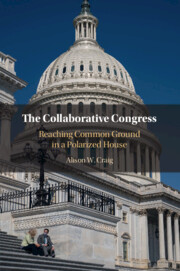Book contents
- Frontmatter
- Dedication
- Contents
- Figures
- Tables
- Acknowledgments
- 1 Collaboration in Congress (Yes, It Exists!)
- 2 Social Exchange in Congress
- 3 Identifying Policy Collaboration
- 4 The Breadth and Substance of Collaborative Issues
- 5 The Most (and Least) Collaborative Members of Congress
- 6 The Interdependence of Collaborative Relationships
- 7 Legislative Benefits of Collaboration
- 8 The Future of Collaboration
- Appendix A Interview Notes
- Appendix B Model Specifications and Fit
- References
- Index
- References
References
Published online by Cambridge University Press: 05 October 2023
- Frontmatter
- Dedication
- Contents
- Figures
- Tables
- Acknowledgments
- 1 Collaboration in Congress (Yes, It Exists!)
- 2 Social Exchange in Congress
- 3 Identifying Policy Collaboration
- 4 The Breadth and Substance of Collaborative Issues
- 5 The Most (and Least) Collaborative Members of Congress
- 6 The Interdependence of Collaborative Relationships
- 7 Legislative Benefits of Collaboration
- 8 The Future of Collaboration
- Appendix A Interview Notes
- Appendix B Model Specifications and Fit
- References
- Index
- References
Summary

- Type
- Chapter
- Information
- The Collaborative CongressReaching Common Ground in a Polarized House, pp. 223 - 234Publisher: Cambridge University PressPrint publication year: 2023

